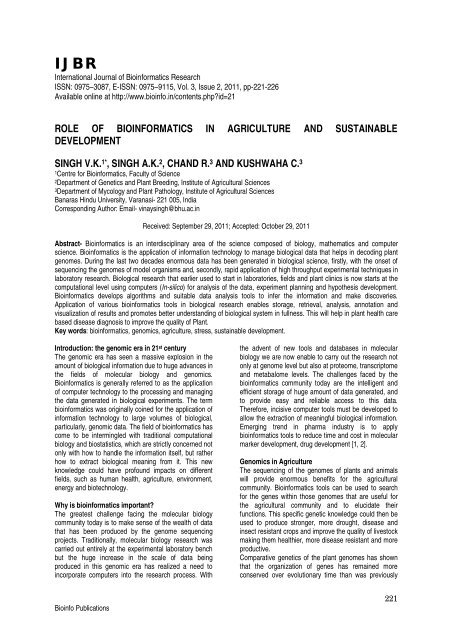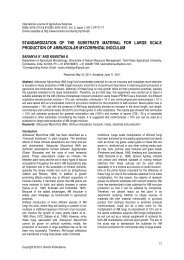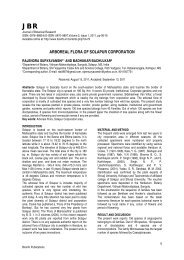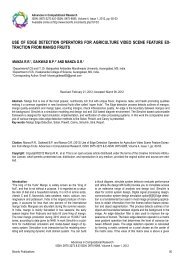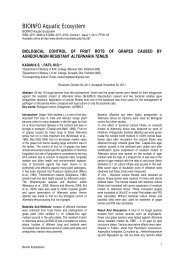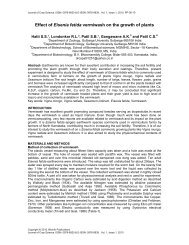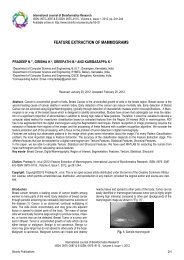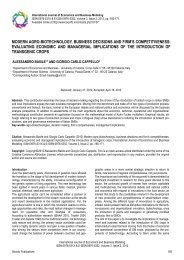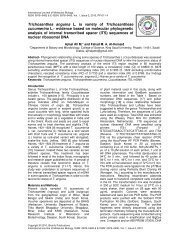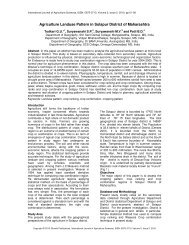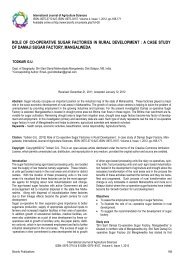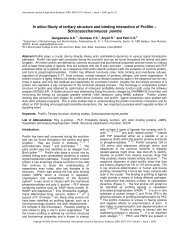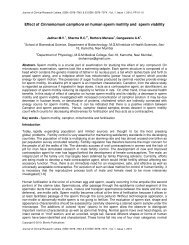Role of bioinformatics in agriculture and sustainable development
Role of bioinformatics in agriculture and sustainable development
Role of bioinformatics in agriculture and sustainable development
You also want an ePaper? Increase the reach of your titles
YUMPU automatically turns print PDFs into web optimized ePapers that Google loves.
IJBR<br />
International Journal <strong>of</strong> Bio<strong>in</strong>formatics Research<br />
ISSN: 0975–3087, E-ISSN: 0975–9115, Vol. 3, Issue 2, 2011, pp-221-226<br />
Available onl<strong>in</strong>e at http://www.bio<strong>in</strong>fo.<strong>in</strong>/contents.php?id=21<br />
ROLE OF BIOINFORMATICS IN AGRICULTURE AND SUSTAINABLE<br />
DEVELOPMENT<br />
SINGH V.K. 1* , SINGH A.K. 2 , CHAND R. 3 AND KUSHWAHA C. 3<br />
1Centre for Bio<strong>in</strong>formatics, Faculty <strong>of</strong> Science<br />
2Department <strong>of</strong> Genetics <strong>and</strong> Plant Breed<strong>in</strong>g, Institute <strong>of</strong> Agricultural Sciences<br />
3Department <strong>of</strong> Mycology <strong>and</strong> Plant Pathology, Institute <strong>of</strong> Agricultural Sciences<br />
Banaras H<strong>in</strong>du University, Varanasi- 221 005, India<br />
Correspond<strong>in</strong>g Author: Email- v<strong>in</strong>ays<strong>in</strong>gh@bhu.ac.<strong>in</strong><br />
Bio<strong>in</strong>fo Publications<br />
Received: September 29, 2011; Accepted: October 29, 2011<br />
Abstract- Bio<strong>in</strong>formatics is an <strong>in</strong>terdiscipl<strong>in</strong>ary area <strong>of</strong> the science composed <strong>of</strong> biology, mathematics <strong>and</strong> computer<br />
science. Bio<strong>in</strong>formatics is the application <strong>of</strong> <strong>in</strong>formation technology to manage biological data that helps <strong>in</strong> decod<strong>in</strong>g plant<br />
genomes. Dur<strong>in</strong>g the last two decades enormous data has been generated <strong>in</strong> biological science, firstly, with the onset <strong>of</strong><br />
sequenc<strong>in</strong>g the genomes <strong>of</strong> model organisms <strong>and</strong>, secondly, rapid application <strong>of</strong> high throughput experimental techniques <strong>in</strong><br />
laboratory research. Biological research that earlier used to start <strong>in</strong> laboratories, fields <strong>and</strong> plant cl<strong>in</strong>ics is now starts at the<br />
computational level us<strong>in</strong>g computers (In-silico) for analysis <strong>of</strong> the data, experiment plann<strong>in</strong>g <strong>and</strong> hypothesis <strong>development</strong>.<br />
Bio<strong>in</strong>formatics develops algorithms <strong>and</strong> suitable data analysis tools to <strong>in</strong>fer the <strong>in</strong>formation <strong>and</strong> make discoveries.<br />
Application <strong>of</strong> various <strong>bio<strong>in</strong>formatics</strong> tools <strong>in</strong> biological research enables storage, retrieval, analysis, annotation <strong>and</strong><br />
visualization <strong>of</strong> results <strong>and</strong> promotes better underst<strong>and</strong><strong>in</strong>g <strong>of</strong> biological system <strong>in</strong> fullness. This will help <strong>in</strong> plant health care<br />
based disease diagnosis to improve the quality <strong>of</strong> Plant.<br />
Key words: <strong>bio<strong>in</strong>formatics</strong>, genomics, <strong>agriculture</strong>, stress, susta<strong>in</strong>able <strong>development</strong>.<br />
Introduction: the genomic era <strong>in</strong> 21 st century<br />
The genomic era has seen a massive explosion <strong>in</strong> the<br />
amount <strong>of</strong> biological <strong>in</strong>formation due to huge advances <strong>in</strong><br />
the fields <strong>of</strong> molecular biology <strong>and</strong> genomics.<br />
Bio<strong>in</strong>formatics is generally referred to as the application<br />
<strong>of</strong> computer technology to the process<strong>in</strong>g <strong>and</strong> manag<strong>in</strong>g<br />
the data generated <strong>in</strong> biological experiments. The term<br />
<strong>bio<strong>in</strong>formatics</strong> was orig<strong>in</strong>ally co<strong>in</strong>ed for the application <strong>of</strong><br />
<strong>in</strong>formation technology to large volumes <strong>of</strong> biological,<br />
particularly, genomic data. The field <strong>of</strong> <strong>bio<strong>in</strong>formatics</strong> has<br />
come to be <strong>in</strong>term<strong>in</strong>gled with traditional computational<br />
biology <strong>and</strong> biostatistics, which are strictly concerned not<br />
only with how to h<strong>and</strong>le the <strong>in</strong>formation itself, but rather<br />
how to extract biological mean<strong>in</strong>g from it. This new<br />
knowledge could have pr<strong>of</strong>ound impacts on different<br />
fields, such as human health, <strong>agriculture</strong>, environment,<br />
energy <strong>and</strong> biotechnology.<br />
Why is <strong>bio<strong>in</strong>formatics</strong> important?<br />
The greatest challenge fac<strong>in</strong>g the molecular biology<br />
community today is to make sense <strong>of</strong> the wealth <strong>of</strong> data<br />
that has been produced by the genome sequenc<strong>in</strong>g<br />
projects. Traditionally, molecular biology research was<br />
carried out entirely at the experimental laboratory bench<br />
but the huge <strong>in</strong>crease <strong>in</strong> the scale <strong>of</strong> data be<strong>in</strong>g<br />
produced <strong>in</strong> this genomic era has realized a need to<br />
<strong>in</strong>corporate computers <strong>in</strong>to the research process. With<br />
the advent <strong>of</strong> new tools <strong>and</strong> databases <strong>in</strong> molecular<br />
biology we are now enable to carry out the research not<br />
only at genome level but also at proteome, transcriptome<br />
<strong>and</strong> metabalome levels. The challenges faced by the<br />
<strong>bio<strong>in</strong>formatics</strong> community today are the <strong>in</strong>telligent <strong>and</strong><br />
efficient storage <strong>of</strong> huge amount <strong>of</strong> data generated, <strong>and</strong><br />
to provide easy <strong>and</strong> reliable access to this data.<br />
Therefore, <strong>in</strong>cisive computer tools must be developed to<br />
allow the extraction <strong>of</strong> mean<strong>in</strong>gful biological <strong>in</strong>formation.<br />
Emerg<strong>in</strong>g trend <strong>in</strong> pharma <strong>in</strong>dustry is to apply<br />
<strong>bio<strong>in</strong>formatics</strong> tools to reduce time <strong>and</strong> cost <strong>in</strong> molecular<br />
marker <strong>development</strong>, drug <strong>development</strong> [1, 2].<br />
Genomics <strong>in</strong> Agriculture<br />
The sequenc<strong>in</strong>g <strong>of</strong> the genomes <strong>of</strong> plants <strong>and</strong> animals<br />
will provide enormous benefits for the agricultural<br />
community. Bio<strong>in</strong>formatics tools can be used to search<br />
for the genes with<strong>in</strong> those genomes that are useful for<br />
the agricultural community <strong>and</strong> to elucidate their<br />
functions. This specific genetic knowledge could then be<br />
used to produce stronger, more drought, disease <strong>and</strong><br />
<strong>in</strong>sect resistant crops <strong>and</strong> improve the quality <strong>of</strong> livestock<br />
mak<strong>in</strong>g them healthier, more disease resistant <strong>and</strong> more<br />
productive.<br />
Comparative genetics <strong>of</strong> the plant genomes has shown<br />
that the organization <strong>of</strong> genes has rema<strong>in</strong>ed more<br />
conserved over evolutionary time than was previously<br />
221
elieved [3, 4, 5, 6]. These f<strong>in</strong>d<strong>in</strong>gs suggest that<br />
<strong>in</strong>formation obta<strong>in</strong>ed from the model crop systems can<br />
be used to suggest improvements to other food crops.<br />
Arabidopsis thaliana (water cress) Oryza sativa (rice),<br />
Triticum aestivum (wheat) <strong>and</strong> Zea mays (Maize) are<br />
examples <strong>of</strong> available complete l<strong>and</strong> plant genomes [7,<br />
8].<br />
What can genome sequence tell us?<br />
Some organisms have multiple copies <strong>of</strong> chromosomes,<br />
diploid, triploid, tetraploid <strong>and</strong> so on. In classical<br />
genetics, <strong>in</strong> a sexually reproduc<strong>in</strong>g organism (typically<br />
eukaryotes) the gamete has half <strong>of</strong> the number <strong>of</strong><br />
chromosome <strong>of</strong> the somatic cell <strong>and</strong> the genome is a full<br />
set <strong>of</strong> chromosomes <strong>in</strong> a gamete. The term genome can<br />
be applied specifically to mean that stored on a complete<br />
set <strong>of</strong> nuclear DNA (i.e., nuclear genome) but can also<br />
be applied to that stored with<strong>in</strong> organelles that conta<strong>in</strong><br />
their own DNA, as with the ‘mitochondrial genome’ or the<br />
‘chloroplast genome’. Additionally, the genome can<br />
comprise non chromosomal genetic elements such as<br />
viruses, plasmids, <strong>and</strong> transposable elements.<br />
Most biological entities that are more complex than a<br />
virus, sometimes or always, carry additional genetic<br />
material besides that which resides <strong>in</strong> their<br />
chromosomes. In such circumstances ‘genome’<br />
describes all <strong>of</strong> the genes <strong>and</strong> <strong>in</strong>formation on non-cod<strong>in</strong>g<br />
DNA that have the potential to be present. In eukaryotes<br />
such as plants, protozoa <strong>and</strong> animals, however,<br />
‘genome’ carries the typical connotation <strong>of</strong> only<br />
<strong>in</strong>formation on chromosomal DNA [9]. The genetic<br />
<strong>in</strong>formation conta<strong>in</strong>ed by DNA with<strong>in</strong> organelles i.e.,<br />
chloroplast <strong>and</strong>/or mitochondria is not considered part <strong>of</strong><br />
the genome. In fact, mitochondria are sometimes said to<br />
have their own genome <strong>of</strong>ten referred to as the<br />
‘mitochondrial genome’. The DNA found with<strong>in</strong> the<br />
chloroplast may be referred to as the ‘plastome’.<br />
Comparative analysis with<strong>in</strong> microbial genome us<strong>in</strong>g<br />
metabolic comparison <strong>and</strong> gene organization at<br />
metabolic reactions level with their operons us<strong>in</strong>g<br />
structure, pathway, reaction, compounds <strong>and</strong> gene<br />
orthologs gives better underst<strong>and</strong><strong>in</strong>g <strong>of</strong> genome<br />
evolution [10, 11]. Variation <strong>in</strong> the genome size, GC<br />
content, codon usage <strong>and</strong> am<strong>in</strong>o acid composition based<br />
on sta<strong>in</strong>s <strong>of</strong> the same species, closely related species<br />
<strong>and</strong> distantly related species. Col<strong>in</strong>earity between gene<br />
set show<strong>in</strong>g their evolutionary differences <strong>in</strong> evolution <strong>of</strong><br />
<strong>in</strong>dividual genes.<br />
Improve nutritional quality <strong>and</strong> growth <strong>in</strong> poorer<br />
soils<br />
Gene-Diet-Disease <strong>in</strong>teraction <strong>of</strong> Nutritional genomics<br />
aims to study the susceptible genes <strong>and</strong> provide dietary<br />
<strong>in</strong>terventions for <strong>in</strong>dividuals at risk <strong>of</strong> such diseases.<br />
Scientists have recently succeeded <strong>in</strong> transferr<strong>in</strong>g genes<br />
<strong>in</strong>to rice to <strong>in</strong>crease levels <strong>of</strong> Vitam<strong>in</strong> A, iron <strong>and</strong> other<br />
micronutrients. This work could have a pr<strong>of</strong>ound impact<br />
<strong>in</strong> reduc<strong>in</strong>g occurrences <strong>of</strong> bl<strong>in</strong>dness <strong>and</strong> anaemia<br />
caused by deficiencies <strong>in</strong> Vitam<strong>in</strong> A <strong>and</strong> iron<br />
respectively. Scientists have <strong>in</strong>serted a gene from yeast<br />
<strong>Role</strong> <strong>of</strong> <strong>bio<strong>in</strong>formatics</strong> <strong>in</strong> <strong>agriculture</strong> <strong>and</strong> susta<strong>in</strong>able <strong>development</strong><br />
International Journal <strong>of</strong> Bio<strong>in</strong>formatics Research<br />
ISSN: 0975–3087, E-ISSN: 0975–9115, Vol. 3, Issue 2, 2011<br />
<strong>in</strong>to the tomato, <strong>and</strong> the result is a plant whose fruit stays<br />
longer on the v<strong>in</strong>e <strong>and</strong> has an extended shelf life.<br />
Bio<strong>in</strong>formatics play an important role to detect the metal<br />
from Metagenomic sequenc<strong>in</strong>g obta<strong>in</strong>s from<br />
contam<strong>in</strong>ated soil [12]. Soil arguably houses the most<br />
complex microbial communities because <strong>of</strong> its ancient<br />
history, complex sets <strong>of</strong> <strong>in</strong>terrelat<strong>in</strong>g gradients, <strong>and</strong><br />
protective, isolat<strong>in</strong>g <strong>and</strong> relatively resource poor <strong>and</strong><br />
stable physical structure. This results <strong>in</strong> an <strong>in</strong>credibly<br />
diverse set <strong>of</strong> gene sequences; at least at the scale soils<br />
are normally sampled. The challenge is no longer<br />
sequence yield, but the analysis <strong>of</strong> those sequences,<br />
<strong>and</strong> especially so due to the short sequence products <strong>of</strong><br />
current sequenc<strong>in</strong>g technologies. Progress has been<br />
made <strong>in</strong> develop<strong>in</strong>g cereal varieties that have a greater<br />
tolerance for soil alkal<strong>in</strong>ity, free alum<strong>in</strong>um <strong>and</strong> iron<br />
toxicities.<br />
Improvement for plant resistance aga<strong>in</strong>st biotic <strong>and</strong><br />
abiotic stresses<br />
Application <strong>of</strong> <strong>in</strong>sect genomics helps <strong>in</strong> the identification<br />
<strong>of</strong> resistance mechanisms <strong>and</strong> f<strong>in</strong>d<strong>in</strong>g the novel target<br />
sites [13]. Genes from Bacillus thur<strong>in</strong>giensis that can<br />
control a number <strong>of</strong> serious pests have been<br />
successfully transferred to cotton, maize <strong>and</strong> potato. This<br />
new ability <strong>of</strong> the plants to resist <strong>in</strong>sect attack means that<br />
the amount <strong>of</strong> <strong>in</strong>secticides be<strong>in</strong>g used can be reduced.<br />
A plant’s first l<strong>in</strong>e <strong>of</strong> defense aga<strong>in</strong>st abiotic stress is <strong>in</strong><br />
its roots. If the soil hold<strong>in</strong>g the plant is healthy <strong>and</strong><br />
biologically diverse, the plant will have a higher chance<br />
<strong>of</strong> surviv<strong>in</strong>g stressful conditions. Plants are extremely<br />
sensitive to the changes, <strong>and</strong> do not generally adapt<br />
quickly. Plants also adapt very differently from one<br />
another, even from a plant liv<strong>in</strong>g <strong>in</strong> the same area. When<br />
a group <strong>of</strong> different plant species was prompted by a<br />
variety <strong>of</strong> different stress signals, such as drought or<br />
cold, each plant responded uniquely. Hardly any <strong>of</strong> the<br />
responses were similar, even though the plants had<br />
become accustomed to exactly the same home<br />
environment. So, species are more likely to become<br />
population threatened, endangered, <strong>and</strong> even ext<strong>in</strong>ct,<br />
when <strong>and</strong> where abiotic stress is especially harsh. By<br />
us<strong>in</strong>g <strong>in</strong> silico genomics technology researcher can<br />
identify defense/ disease resistance gene-enzyme with<br />
their promoter region <strong>and</strong> transcription factor which help<br />
to enhance the immunity <strong>and</strong> defence mechanism [14,<br />
15].<br />
Similarity Search<strong>in</strong>g Tools<br />
The exponential growth <strong>of</strong> genomics is due to<br />
computational challenges <strong>of</strong> systematically collect<strong>in</strong>g,<br />
stor<strong>in</strong>g, organiz<strong>in</strong>g, manipulat<strong>in</strong>g visualiz<strong>in</strong>g <strong>and</strong><br />
analyz<strong>in</strong>g large amounts <strong>of</strong> biological <strong>in</strong>formation come<br />
from the experiments carried out by the biologists.. Thus,<br />
<strong>bio<strong>in</strong>formatics</strong>, <strong>in</strong> its broad sense, can be seen as<br />
provid<strong>in</strong>g both the <strong>in</strong>frastructure <strong>and</strong> the scientific<br />
framework <strong>in</strong> which biologists take <strong>in</strong>formation <strong>and</strong> use<br />
computers to help convert it <strong>in</strong>to knowledge [16]. Apart<br />
from the fact that <strong>bio<strong>in</strong>formatics</strong> is a newly recognized<br />
discipl<strong>in</strong>e; there is an impressive diversity <strong>of</strong><br />
222
io<strong>in</strong>formatics resources currently available. Though a<br />
wide array <strong>of</strong> commercial resources exist, some <strong>of</strong> which<br />
are ideally suited to specific tasks, <strong>and</strong> freely available.<br />
Many <strong>of</strong> the databases <strong>and</strong> analysis tools we describe<br />
here are hosted by government or academic research<br />
centers <strong>and</strong> can be accessed via user-friendly web<br />
<strong>in</strong>terfaces (Table .1).<br />
An excellent resource to the world <strong>of</strong> genomic databases<br />
is the annual database issue <strong>of</strong> the journal ‘Nucleic Acids<br />
Research’, published on the 1 st <strong>of</strong> January each year<br />
(www3.oup.co.uk/nar/database/c/). In addition, Genbank<br />
[17], National Center for Biotechnology Information<br />
(NCBI), the European Molecular Biology Laboratory<br />
(EMBL) <strong>and</strong> the DNA Databank <strong>of</strong> Japan (DDBJ), are<br />
pioneer as the DNA <strong>and</strong> prote<strong>in</strong> sequence repository. A<br />
variety <strong>of</strong> crop <strong>and</strong> model plant specific genomic<br />
databases are also accessible through UKCropNet<br />
<strong>in</strong>clud<strong>in</strong>g Gra<strong>in</strong>Genes, (which holds molecular <strong>and</strong><br />
phenotypic <strong>in</strong>formation on wheat, barley, oats, rye <strong>and</strong><br />
sugarcane), <strong>and</strong> MaizeDB (for maize).<br />
Some databases are specific to somewhat larger<br />
taxonomic assemblages e.g., the Gramene database,<br />
which aims to <strong>in</strong>tegrate genomic <strong>in</strong>formation from among<br />
all grasses us<strong>in</strong>g the rice genomic sequence as a focal<br />
po<strong>in</strong>t. Pfam, a prote<strong>in</strong> sequence signature database, is a<br />
derived database [28]. Derived databases <strong>in</strong> plant<br />
genomics frequently only <strong>in</strong>clude those plant systems<br />
hav<strong>in</strong>g the most abundant data. One example is the set<br />
<strong>of</strong> Gene Indices at The Institute for Genomic Research<br />
(TIGR), which is a collection <strong>of</strong> much focussed<br />
databases, each cover<strong>in</strong>g a different plant, animal,<br />
protist or fungal species. Each Gene Index<br />
computationally assembles the non-redundant set <strong>of</strong><br />
gene sequences for that organism, with l<strong>in</strong>ks to<br />
expression, homology <strong>and</strong> other <strong>in</strong>formation.<br />
Plant biologists are, <strong>of</strong> course, also <strong>in</strong>terested <strong>in</strong> plant<br />
symbionts <strong>and</strong> disease caus<strong>in</strong>g organisms. A number <strong>of</strong><br />
plant pathogenic bacteria <strong>and</strong> fungi have either been<br />
sequenced <strong>in</strong> their entirety, <strong>in</strong>clud<strong>in</strong>g Agrobacterium<br />
tumefaciens, Ralstonia solanacearum <strong>and</strong> Xylella<br />
fastidiosa, or are the subject <strong>of</strong> ongo<strong>in</strong>g sequenc<strong>in</strong>g<br />
projects, such as Magnaporthe grisea, Pseudomonas<br />
syr<strong>in</strong>gae pv. tomato <strong>and</strong> Xanthomonas campestris. In<br />
addition, a variety <strong>of</strong> plant viral genomes have been<br />
deposited <strong>in</strong> Genbank. The Genomes Onl<strong>in</strong>e Database<br />
(GOLD) is a regularly updated onl<strong>in</strong>e list<strong>in</strong>g <strong>of</strong><br />
prokaryotic <strong>and</strong> eukaryotic genome projects that have<br />
been completed or that are under way. TIGR <strong>of</strong>fers what<br />
it calls the Comprehensive Microbial Resource database,<br />
which allows exploration <strong>and</strong> comparison <strong>of</strong> the<br />
annotated microbial sequences.<br />
Sequence Analysis<br />
The term "sequence analysis" <strong>in</strong> biology implies<br />
subject<strong>in</strong>g a DNA or peptide sequence to sequence<br />
alignment, sequence databases, repeated sequence<br />
searches, or other <strong>bio<strong>in</strong>formatics</strong> methods on a<br />
computer. In <strong>bio<strong>in</strong>formatics</strong>, a sequence alignment is a<br />
way <strong>of</strong> arrang<strong>in</strong>g the sequences <strong>of</strong> DNA, RNA, or prote<strong>in</strong><br />
to identify regions <strong>of</strong> similarity that may be a<br />
Bio<strong>in</strong>fo Publications<br />
S<strong>in</strong>gh VK, S<strong>in</strong>gh AK, Ch<strong>and</strong> R <strong>and</strong> Kushwaha C<br />
consequence <strong>of</strong> functional, structural, or evolutionary<br />
relationships between the sequences. Sequence<br />
analysis can be used to assign function to genes <strong>and</strong><br />
prote<strong>in</strong>s by the study <strong>of</strong> the similarities between the<br />
compared sequences [29]. Nowadays there are many<br />
tools <strong>and</strong> techniques that provide the sequence<br />
comparisons (sequence alignment) <strong>and</strong> analyze the<br />
alignment product to underst<strong>and</strong> the biology.<br />
The most commonly used similarity search method is the<br />
Basic Local Alignment Search Tool [BLAST; 30]. BLAST<br />
is a heuristic modification <strong>of</strong> the Smith–Waterman (1981)<br />
[31] algorithm <strong>and</strong> <strong>in</strong> practice it is widely used. In BLAST,<br />
statistical methods are used to determ<strong>in</strong>e the likelihood<br />
<strong>of</strong> a particular alignment between sequences or<br />
sequence regions aris<strong>in</strong>g by chance given the size <strong>and</strong><br />
composition <strong>of</strong> the database be<strong>in</strong>g searched [32, 33].<br />
The most popular onl<strong>in</strong>e <strong>in</strong>terface to BLAST is available<br />
at NCBI, where a st<strong>and</strong>alone version is also available for<br />
download<strong>in</strong>g. There are several parameters controll<strong>in</strong>g<br />
the behaviour <strong>of</strong> the BLAST algorithm, <strong>and</strong> these need to<br />
be carefully considered. The set <strong>of</strong> tools allows us to<br />
carry out further, more detailed analysis on our query<br />
sequence <strong>in</strong>clud<strong>in</strong>g evolutionary analysis, identification<br />
<strong>of</strong> mutations, hydropathy regions, CpG isl<strong>and</strong>s <strong>and</strong><br />
compositional biases [34]. Sequence alignments are<br />
useful <strong>in</strong> <strong>bio<strong>in</strong>formatics</strong> for identify<strong>in</strong>g sequence<br />
similarity, produc<strong>in</strong>g phylogenetic trees [35, 36] <strong>and</strong><br />
develop<strong>in</strong>g homology models <strong>of</strong> prote<strong>in</strong> structures [37].<br />
Prote<strong>in</strong> Function Analysis<br />
In prote<strong>in</strong> functional studies we compare the prote<strong>in</strong><br />
sequence to the secondary (or derived) prote<strong>in</strong><br />
databases that conta<strong>in</strong> <strong>in</strong>formation on motifs, signatures<br />
<strong>and</strong> prote<strong>in</strong> doma<strong>in</strong>s. Highly significant hits aga<strong>in</strong>st these<br />
different pattern databases allow us to approximate the<br />
biochemical function <strong>of</strong> our query prote<strong>in</strong> [38, 39]. Motif<br />
f<strong>in</strong>d<strong>in</strong>g, also known as pr<strong>of</strong>ile analysis, constructs global<br />
multiple sequence alignments that attempt to align short<br />
conserved sequence motifs among the sequences <strong>in</strong> the<br />
query set. This is usually done by first construct<strong>in</strong>g a<br />
general global multiple sequence alignment, after which<br />
the highly conserved regions are isolated <strong>and</strong> used to<br />
construct a set <strong>of</strong> pr<strong>of</strong>ile matrices. The pr<strong>of</strong>ile matrix for<br />
each conserved region is arranged like a scor<strong>in</strong>g matrix<br />
but its frequency counts for each am<strong>in</strong>o acid or<br />
nucleotide at each position are derived from the<br />
conserved region's character distribution rather than from<br />
a more general empirical distribution [40]. The pr<strong>of</strong>ile<br />
matrices are then used to search other sequences for<br />
occurrences <strong>of</strong> the motif they characterize.<br />
In silico Cis-act<strong>in</strong>g elements <strong>and</strong> Transcription factor<br />
studies<br />
Eukaryotic transcription is more complex than<br />
prokaryotic transcription. In eukaryotes the genetic<br />
material (DNA), <strong>and</strong> therefore transcription, is primarily<br />
localized to the nucleus, where it is separated from the<br />
cytoplasm by the nuclear membrane. DNA is also<br />
present <strong>in</strong> mitochondria <strong>and</strong> mitochondria utilize a<br />
specialized RNA polymerase for transcription. This<br />
223
allows for the temporal regulation <strong>of</strong> gene expression<br />
through the sequestration <strong>of</strong> the RNA <strong>in</strong> the nucleus, <strong>and</strong><br />
allows for selective transport <strong>of</strong> RNAs to the cytoplasm,<br />
where the ribosomes reside.<br />
Among eukaryotes, the core promoter <strong>of</strong> prote<strong>in</strong>encod<strong>in</strong>g<br />
gene conta<strong>in</strong>s b<strong>in</strong>d<strong>in</strong>g sites for the basal<br />
transcription complex <strong>and</strong> RNA polymerase II, <strong>and</strong> is<br />
normally with<strong>in</strong> about 50 bases upstream <strong>of</strong> the<br />
transcription <strong>in</strong>itiation site. Further transcriptional<br />
regulation is provided by upstream control elements<br />
(UCEs), usually present with<strong>in</strong> about 200 bases<br />
upstream <strong>of</strong> the <strong>in</strong>itiation site [22]. The core promoter for<br />
Pol II sometimes conta<strong>in</strong>s a TATA box, the highly<br />
conserved DNA recognition sequence for the TATA box<br />
b<strong>in</strong>d<strong>in</strong>g prote<strong>in</strong> (TBP) whose b<strong>in</strong>d<strong>in</strong>g <strong>in</strong>itiates<br />
transcription complex assembly at the promoter [23, 18].<br />
Some genes also have enhancer elements that can be<br />
thous<strong>and</strong>s <strong>of</strong> bases upstream or downstream <strong>of</strong> the<br />
transcription <strong>in</strong>itiation site [41]. Comb<strong>in</strong>ations <strong>of</strong> these<br />
upstream control elements <strong>and</strong> enhancers regulate <strong>and</strong><br />
amplify the formation <strong>of</strong> the basal transcription complex.<br />
The transcription <strong>of</strong> a gene can be regulated by cisact<strong>in</strong>g<br />
elements with<strong>in</strong> the regulatory regions <strong>of</strong> the DNA,<br />
<strong>and</strong> trans-act<strong>in</strong>g factors that <strong>in</strong>clude transcription factors<br />
<strong>and</strong> the basal transcription complex.<br />
FUTURE PROSPECTS<br />
Harness<strong>in</strong>g the plant- pathogen genomics<br />
Organisms that cause <strong>in</strong>fectious disease <strong>in</strong>clude fungi,<br />
oomycetes, bacteria, viruses, viroids, virus-like<br />
organisms, phytoplasmas, protozoa, nematodes <strong>and</strong><br />
parasitic plants [42]. Plant pathology <strong>in</strong>volves the study<br />
<strong>of</strong> pathogen identification, disease etiology, disease<br />
cycles, economic impact, plant disease epidemiology,<br />
plant disease resistance, how plant diseases affect<br />
humans <strong>and</strong> animals, pathosystem genetics, <strong>and</strong><br />
management <strong>of</strong> plant diseases. Genome sequenced<br />
from fungi, oomycetes, bacteria, viruses, viroids, viruslike<br />
organisms, phytoplasmas, protozoa, nematodes <strong>and</strong><br />
parasitic plants gives opportunities to underst<strong>and</strong> plant-<br />
pathogen <strong>in</strong>teraction which helps to management,<br />
diagnose the disease <strong>and</strong> make disease resistance<br />
transgenic plant [43]. In its most simple form, the genefor-gene<br />
hypothesis states that plants conta<strong>in</strong> s<strong>in</strong>gle<br />
dom<strong>in</strong>ant resistance R genes that specifically recognize<br />
pathogens that conta<strong>in</strong> complementary avirulence<br />
genes. Avirulence genes can be def<strong>in</strong>ed as genes <strong>in</strong> the<br />
pathogen that encode a prote<strong>in</strong> product that is<br />
conditionally recognized directly or <strong>in</strong>directly only by<br />
those plants that conta<strong>in</strong> the complementary R gene.<br />
To survive, plants must defend themselves<br />
from numerous pathogens. Some defenses are<br />
constitutive, such as various pre-formed anti-microbial<br />
compounds, whereas others are activated by pathogen<br />
recognition. The recognition process <strong>in</strong>cludes the<br />
product <strong>of</strong> a dom<strong>in</strong>ant or semi-dom<strong>in</strong>ant resistance R<br />
gene present <strong>in</strong> the plant <strong>and</strong> the correspond<strong>in</strong>g<br />
dom<strong>in</strong>ant avirulence (Avr) factor encoded by or derived<br />
from the pathogen. The recognition <strong>of</strong> the Avr factor by<br />
the host plant starts one or more signal transduction<br />
<strong>Role</strong> <strong>of</strong> <strong>bio<strong>in</strong>formatics</strong> <strong>in</strong> <strong>agriculture</strong> <strong>and</strong> susta<strong>in</strong>able <strong>development</strong><br />
International Journal <strong>of</strong> Bio<strong>in</strong>formatics Research<br />
ISSN: 0975–3087, E-ISSN: 0975–9115, Vol. 3, Issue 2, 2011<br />
pathways that activate several <strong>of</strong> the plant’s defenses,<br />
thus compromis<strong>in</strong>g the ability <strong>of</strong> the pathogen to colonize<br />
the plant. The <strong>in</strong>teractions between plants <strong>and</strong><br />
pathogens are specific, complex <strong>and</strong> dynamic [44]. The<br />
identification <strong>of</strong> resistant genes <strong>in</strong> the germplasm <strong>of</strong> wild<br />
species <strong>of</strong> field crops <strong>and</strong> their subsequent <strong>in</strong>trogression<br />
<strong>in</strong>to commercial cultivars has been the ma<strong>in</strong> approach <strong>of</strong><br />
many plant breeders. Several strategies for the<br />
identification, characterization <strong>and</strong> functional analysis <strong>of</strong><br />
plant genes <strong>in</strong>volved <strong>in</strong> the trigger<strong>in</strong>g, signal<strong>in</strong>g <strong>and</strong><br />
response to biotic <strong>and</strong> abiotic factors have been recently<br />
envisaged. In-silico biology plays an important role to<br />
underst<strong>and</strong> the plant pathogen <strong>in</strong>teraction at gene <strong>and</strong><br />
genome <strong>of</strong> plants <strong>and</strong> pathogens [45].<br />
References<br />
[1] Untergasser A., Nijveen H., Rao X., Bissel<strong>in</strong>g<br />
T., Geurts R. <strong>and</strong> Leunissen J.A.M. (2007)<br />
Nucleic Acids Research, 35, W71-W74.<br />
[2] Kumari N., S<strong>in</strong>gh V.K., Narayan O.P., Rai L.C.<br />
(2011) Onl<strong>in</strong>e Journal <strong>of</strong> Bio<strong>in</strong>formatics, 12,<br />
289-303.<br />
[3] Mahalakshmi V. <strong>and</strong> Ortiz R. (2001) Electronic<br />
Journal <strong>of</strong> Biotechnology, 3.<br />
[4] Matthews D.E., Carollo V.L., Lazo G.R. <strong>and</strong><br />
Anderson O.D. (2003). Nucleic Acids<br />
Research, 31, 183-186.<br />
[5] Caetano-Anolles. (2005) Crop Science, 45,<br />
1809-1816.<br />
[6] Jaiswal P., Ni J., Yap I., Ware D., Spooner W.,<br />
Youens-Clark K., Ren L., Liang C., Zhao W.,<br />
Ratnapu K., Faga B., Canaran P., Fogleman<br />
M., Hebbard C., Avraham S., Schmidt S.,<br />
Casstevens T.M., Buckler E.S., Ste<strong>in</strong> L. <strong>and</strong><br />
McCouch S. (2006) Nucleic Acids Research,<br />
34, D717-D723.<br />
[7] Paterson A.H., Freel<strong>in</strong>g M. <strong>and</strong> Sasaki, T.<br />
(2005) Genome Research, 15, 1643-1650.<br />
[8] Varshney R.K., Hois<strong>in</strong>gton A.D. <strong>and</strong> Tyagi K.A.<br />
(2006) Trends <strong>in</strong> Biotechnology, 24, 1-10.<br />
[9] Angellotti M.C., Bhuiyan S.B., Chen G. <strong>and</strong><br />
Wan Xiu-Feng (2007) Nucleic Acids Research,<br />
35, W132-W136.<br />
[10] Kale U.K., Bhosle S.G., Manjari G.S., Joshi M.,<br />
Bansode S. <strong>and</strong> Kolaskar A.S. (2006) BMC<br />
Bio<strong>in</strong>formatics, S12-S27.<br />
[11] Tsuru T. <strong>and</strong> Kobayashi I. (2008 Molecular<br />
Biology Evolution, 25, 2457-2473.<br />
[12] H<strong>and</strong>elsman J. (2004) Microbiology <strong>and</strong><br />
Molecular Biology Reviews, 68, 669-685.<br />
[13] Cory J.S. <strong>and</strong> Hoover K. (2006) Trends <strong>in</strong><br />
Ecology <strong>and</strong> Evolution, 21, 278-286.<br />
[14] Kummerfeld S.K. <strong>and</strong> Teichmann S.A. (2006)<br />
Nucleic Acids Research, 34, D74-–D81.<br />
[15] P<strong>and</strong>ey S.P. <strong>and</strong> Somssich I.E. (2009) Plant<br />
Physiology, 150, 1648-1655.<br />
[16] Todd J. Vision <strong>and</strong> Aoife McLysaght (2003)<br />
H<strong>and</strong>book <strong>of</strong> Plant Biotechnology (Ed. Paul<br />
Christou <strong>and</strong> Harry Klee). John Wiley <strong>and</strong><br />
Sons Ltd.<br />
224
[17] Pruitt K.D., Tatusova T. <strong>and</strong> Maglott D.R.<br />
(2007) Nucleic Acids Research, 35, D61–D65.<br />
[18] Gao G., Zhong Y., Guo A., Zhu Q., Tang W.,<br />
Zheng W., Gu X., Wei L. <strong>and</strong> Luo j. (2006)<br />
Bio<strong>in</strong>formatics, 22, 1286-1287.<br />
[19] Tateno Y., Imanishi T., Miyazaki S., Fukami-<br />
Kobayashi K., Saitou N., Sugawara H. <strong>and</strong><br />
Gojobori T. (2002) Nucleic Acid Research, 30,<br />
27-30.<br />
[20] Dong Q., Lawrence C.J., Schlueter S.D.,<br />
Wilkerson M.D., Kurtz S., Lushbough C. <strong>and</strong><br />
Brendel V. (2005) Plant Physiology, 139, 610-<br />
618.<br />
[21] Sakata K., Nagamura Y., Numa H., Antonio<br />
B.A., Nagasaki H., Idonuma A., WatanabeW.,<br />
Shimizu Y., Horiuchi I., Matsumoto T., Sasaki<br />
T. <strong>and</strong> Higo K.(2002) Nucleic Acids Research,<br />
30, 98-102.<br />
[22] Iida K., Seki M., Sakurai T., Satou M., Akiyama<br />
K., Toyoda T., Konagaya A. <strong>and</strong> Sh<strong>in</strong>ozaki K.<br />
(2005) DNA Research, 12, 247-256.<br />
[23] Guo A., He K., Liu D., Bai S., Gu S., Wei, L.<br />
<strong>and</strong> Luo J. (2005) Bio<strong>in</strong>formatics, 21, 2568-<br />
2569.<br />
[24] Riano-Pachon D.M., Ruzicic S., Dreyer I. <strong>and</strong><br />
Mueller-Roeber B. (2007) BMC Bio<strong>in</strong>formatics,<br />
8, 42-53.<br />
[25] Marla S., S<strong>in</strong>gh V.K. (2007) In Silico Biology, 7,<br />
543-555.<br />
[26] S<strong>in</strong>gh V.K., Ambwani S, Marla S., Kumar A.<br />
(2009) Bio<strong>in</strong>formation, 4, 182-183.<br />
[27] Sansever<strong>in</strong>o W., Roma G., Simone M.D.,<br />
Fa<strong>in</strong>o M., Melito S., Stupka E., Frusciante L.<br />
<strong>and</strong> Ercolano M.R. (2010) Nucleic Acids<br />
Research, 38, D814-D821.<br />
[28] F<strong>in</strong>n R.D., Mistry J., Schuster-Bockler B.,<br />
Griffiths-Jones S., Hollich V., lassmann T.,<br />
Moxon S., Marshall M., Khanna A., Durb<strong>in</strong> R.,<br />
Eddy S.R., Sonnhammer E.L.L. <strong>and</strong> Bateman<br />
A. (2006) Nucleic Acids Research, 34, D247-<br />
D251.<br />
[29] Stormo G.D. (2000) Bio<strong>in</strong>formatics, 16, 16-23.<br />
[30] Altschul S.F., Gish W., Miller W., Myers E.W.<br />
<strong>and</strong> Lipman D.J. (1990) Journal <strong>of</strong> Molecular<br />
Biology, 215, 403-410.<br />
Bio<strong>in</strong>fo Publications<br />
S<strong>in</strong>gh VK, S<strong>in</strong>gh AK, Ch<strong>and</strong> R <strong>and</strong> Kushwaha C<br />
[31] Smith T.F., <strong>and</strong> Waterman M.S. (1981) Journal<br />
<strong>of</strong> Molecular Biology, 147, 195–197.<br />
[32] Kushwaha H., Gupta N., S<strong>in</strong>gh V.K., Kumar A.,<br />
Yadav D. (2008) Onl<strong>in</strong>e Journal <strong>of</strong><br />
Bio<strong>in</strong>formatics, 9, 130-143.<br />
[33] Kushwaha H., Gupta S., S<strong>in</strong>gh V.K., Rastogi S.<br />
<strong>and</strong> Yadav D. (2010) Molecular Biology<br />
Reporter (OI: 10.1007/s11033-010-0650-9).<br />
[34] Puigbo P., Guzma E., Romeu A. <strong>and</strong> Garcia-<br />
Vallve A. (2007) Nucleic Acids Research, 35,<br />
W126-W131.<br />
[35] Yadav P.K., S<strong>in</strong>gh V.K., Yadav S., Yadav<br />
K.D.S., <strong>and</strong> Yadav D. (2009) Biochemistry<br />
(Mosc), 9, 1049-1055.<br />
[36] Dubey AK, Yadav S, Kumar M, S<strong>in</strong>gh VK,<br />
Sarangi BK, Yadav D. (2010) Enzyme<br />
Research, 19, 2010:950230.<br />
[37] Tamura K., Dudley J., Nei M. <strong>and</strong> Kumar S.<br />
(2007) Molecular Biology Evolution, 24, 1596-<br />
1599.<br />
[38] Bailey T.L. <strong>and</strong> Gribskov M. (1998)<br />
Bio<strong>in</strong>formatics, 14, 48-54.<br />
[39] Bailey T.L., Williams N., Misleh C. <strong>and</strong> Li W.W.<br />
(2006) Nucleic Acids Research, 34, W369-<br />
W373.<br />
[40] Castro E. D., Sigrist C.J.A., Gattiker A.,<br />
Bulliard V., Langendijk-Genevaux P.S.,<br />
Gasteiger E., Bairoch A. <strong>and</strong> Hulo N. (2006)<br />
Nucleic Acids Research, 34, W362-W365.<br />
[41] Yadav D., S<strong>in</strong>gh V.K., S<strong>in</strong>gh N.K. (2007)<br />
Onl<strong>in</strong>e Journal <strong>of</strong> Bio<strong>in</strong>formatics, 8,: 1-9.<br />
[42] Montes<strong>in</strong>os E., Bonaterra E.A., Badosa E.E.,<br />
Frances E.J., Alemany J., Llorente E.I.,<br />
Moragrega E.C. (2002) International<br />
Microbiology, 5, 169-175.<br />
[43] Kim E., Kosack H. <strong>and</strong> Jonathan D.G.J.<br />
(1997)Annual Review <strong>of</strong> Plant Physiology, 48,<br />
575-607.<br />
[44] Matsumura H., Reich S., Ito A., Saitoh H.,<br />
Kamoun S., W<strong>in</strong>ter P., Kahl G., Reuter M., Kru<br />
ger D.H. <strong>and</strong> Terauchi R. (2003) PNAS, 100,<br />
15718-15723.<br />
[45] Wan J., Dunn<strong>in</strong>g F.M., Bent A.F. (2002)<br />
Functional <strong>and</strong> Integrative Genomics, 2, 259-<br />
273.<br />
225
<strong>Role</strong> <strong>of</strong> <strong>bio<strong>in</strong>formatics</strong> <strong>in</strong> <strong>agriculture</strong> <strong>and</strong> susta<strong>in</strong>able <strong>development</strong><br />
Table1- List <strong>of</strong> Databases used for homology/similarity search.<br />
Database Description Website Reference<br />
NCBI National Center for<br />
Biotechnology Information<br />
http://www.ncbi.nlm.nih.gov<br />
[17]<br />
DRTF Database <strong>of</strong> Rice<br />
transcription factor<br />
http://drtf.cbi.pku.edu.cn/ [18]<br />
DDBJ DNA Data Bank <strong>of</strong> Japan http://www.ddbj.nig.ac.jp/Welcomee.htm<br />
l<br />
[19]<br />
PGD Plant Genome Data base http://www.plantgdb.org/ [20]<br />
RICE-GAAS Rice Genome Automated<br />
Annotation System<br />
http://ricegaas.dna.affrc.go.jp [21]<br />
GRAINGENES genome database for smallgra<strong>in</strong><br />
crops<br />
http://www.gra<strong>in</strong>genes.org [4]<br />
GRAMENE cereal genome database http://www.gramene.org/ [6]<br />
RARTF RIKEN Arabidopsis<br />
transcription factor<br />
http://rarge.gsc.riken.jp/rartf/ [22]<br />
DATF Database <strong>of</strong> Arabidopsis<br />
transcription factors<br />
http://datf.cbi.pku.edu.cn/ [23]<br />
PlnTFDB plant transcription factor<br />
database<br />
http://plntfdb.bio.uni-potsdam.de. [24]<br />
PGV Pathogenic Genome Viewer http://www.<strong>in</strong>silicogenomics.<strong>in</strong>/toolsagro-bacterium.asp<br />
[25]<br />
Database <strong>of</strong> Cry genes http://www.<strong>in</strong>silicogenomics.<strong>in</strong>/cry-bt- [26]<br />
Cry-Bt identifier<br />
search.asp<br />
PRGdb platform for plant resistance<br />
gene analysis<br />
http://prgdb.cbm.fvg.it/ [27]<br />
International Journal <strong>of</strong> Bio<strong>in</strong>formatics Research<br />
ISSN: 0975–3087, E-ISSN: 0975–9115, Vol. 3, Issue 2, 2011<br />
226


